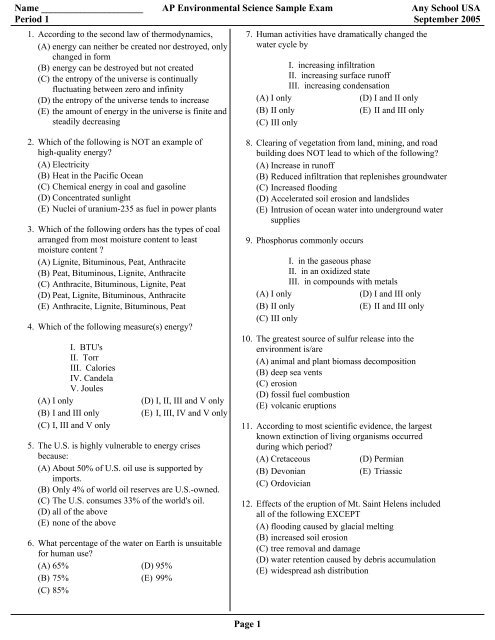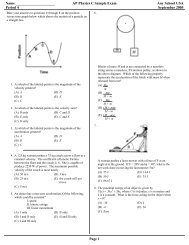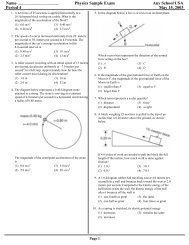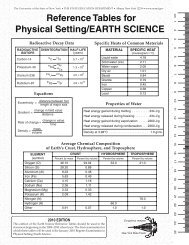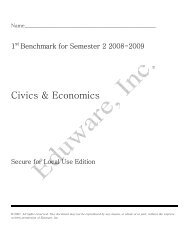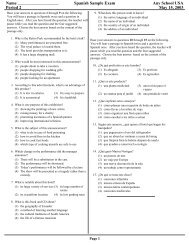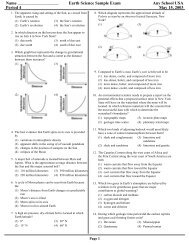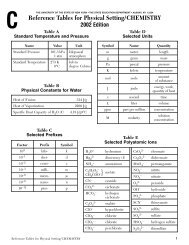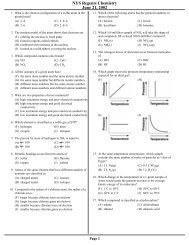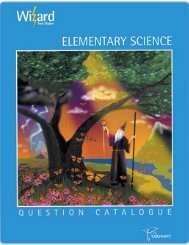The Wizard Test Maker - Eduware
The Wizard Test Maker - Eduware
The Wizard Test Maker - Eduware
You also want an ePaper? Increase the reach of your titles
YUMPU automatically turns print PDFs into web optimized ePapers that Google loves.
AP Environmental Science Sample Exam35. <strong>The</strong> graph below represents the population of a city in which country?(A) Uganda, a less-developed country(B) United States, a highly-developed country(E) India, a highly-developed36. Xeriscaping conserves water by(A) purifying water used industrially for cooling(B) reducing household shower water consumptionneeds(C) reducing household lawn irrigation needs(D) reducing water leakage from fire hydrants(E) purifying gray water and sewage fornon-drinking use37. Bottled waterI. is frequently contaminatedII. is far safer than tap waterIII. is tested by the FDA(A) I only(D) II and III only(B) II only(E) I, II and III(C) III only38. Which of the following would have the best waterholding capacity yet the poorest aeration?(A) Clay(D) Silt(B) Loam(E) Sand(C) Gravel(C) Canada, a less-developed country(D) Australia, a less-developed country39. <strong>The</strong> greatest precipitation in the United States isfound in(A) the Southwest (D) the PacificNorthwest(B) the Northeast (E) the Great LakesRegion(C) the Midwest40. While searching for oil deposits, mining companiesshould look for what type of rocks?(A) Dolostone and agate (D) Granite and basalt(B) Coal and sandstone (E) Schist and marble(C) Limestone and shale41. A forest that has large numbers of standing dead treesand fallen logs, providing habitats for large numbersof species is known as a(A) old-growth forest (D) new growth forest(B) primary growth forest (E) tertiary growthforest(C) secondary growth forestPage 4
78. Increasing atmospheric carbon dioxide concentrationssuggest that(A) carbon has increased in abundance(B) atmospheric changes have favored the productionof carbon dioxide to that of carbon tetrachloride(C) anthropogenic causes have a noticeable effectupon the atmosphere(D) global temperatures may not be life-sustaining bythe end of the twenty-first century(E) the overall rate of photosynthesis has decreasedAP Environmental Science Sample Exam83. Base your answer to the following question on thediagram below.79. Ozone depletion has all of the following effects uponthe environment EXCEPT(A) a reduction in food-crop production(B) a decrease in carbon dioxide concentration(C) a disruption of marine food chains(D) an increased occurrence of skin cancer(E) a reduction in primary productivity in marineecosystems80. Which of the following most accurately describes theseasonal thinning process of ozone over Antarctica?(A) ODCs accumulate in the Antarctic water duringthe spring until the heat of the summerevaporates ODCs into the atmosphere to destroyozone.(B) Cl molecules accumulate in the form of cloudsduring the fall until the cold of Antarctic winterprecipitates out CFCs to destroy ozone.(C) ClO and Cl molecules collect on the surface ofice crystals which accumulate during Antarcticspring until light releases large amounts of ClOin the summer to destroy ozone.(D) Cl 2 O 2 molecules accumulate in a swirling vortexduring Antarctic winter until light releases largeamounts of Cl in the spring to destroy ozone.(E) Cl molecules accumulate in the form of icecrystals during Antarctic winter until lightreleases large amounts of Cl in the spring todestroy ozone.81. Successful invader species are characterized by all ofthe following EXCEPT(A) high reproductive rate (D) generalist niche(B) K-selection(E) high dispersal rate(C) high genetic variability82. <strong>The</strong> average species becomes extinct after(A) 500 to 1000 years(B) 50,000 to 100,000 years(C) 500,000 to 1,000,000 years(D) 5,000,000 to 10,000,000 years(E) 50,000,000 to 100,000,000 years<strong>The</strong> diagram below represents which of thefollowing?(A) Downwell(D) Warm water(B) Hurricane(E) Any of the above(C) Upwell84. According to scientists which of the followingdescribes how climate change is likely to affectbiodiversity in the future?(A) Terrestrial ecosystems are expected to be morestrongly affected than more robust freshwaterecosystems.(B) Tropical areas will change in biodiversity morethan arctic areas, being much more productive.(C) Northern temperate ecosystems inhabited heavilyby humans are expected to change in biodiversitythe most.(D) Invasive species are expected to dominate infreshwater systems, especially lakes.(E) Biodiversity will increase because of changinghabitats, allowing new species to evolve.85. Increasing ultraviolet radiation is likely to have thegreatest effect upon freshwater organisms in the(A) limnetic zone (D) syntrophic zone(B) profundal zone (E) hydrologic zone(C) benthic zone86. <strong>The</strong> chance that a pesticide will be biomagnified isgreatest if the substance has a high degree of(A) toxicity(D) volatility(B) persistence(E) combustibility(C) water solubilityPage 9
87.AP Environmental Science Sample ExamWhich of the following most likely caused the record low of ozone level in 1994?(A) Eruption of Mt. Pinatubo in 1991 (C) Sudden environmental policy change in 1990(B) Record high CO 2 emissions from heavy industries (D) Eruption of Mount St. Helens in 1980(E) Record high NO 2 emissions from chemical industries88. Global warming conditions are likely to mimic ElNiño conditions in that there will be(A) a warming of the Atlantic tropical waters(B) a cooling of Pacific equatorial waters(C) a decrease in precipitation in Australia(D) an increase in precipitation in the Amazonrainforest(E) warmer than average winters in the NortheastUnited States89. Which of the following is an example of risk-benefitanalysis, or cost-risk analysis?(A) Mine Safety Laws(B) Automobile speed laws(C) National health insurance coverage(D) Clean Air Act(E) None of the above90. Repercussion costs to a polluting industry mightinclude(A) increased taxes(B) losses from boycotting(C) equipment maintenance costs(D) rental costs on oil spill cleanup equipment(E) gray water storage equipment purchases91. Dematerialization is the process by which(A) large unstable nuclei decay into smaller, morestable nuclei(B) mass is lost during the fission of two nuclei andconverted to radiant energy(C) products decrease in weight over time withimproved technology(D) bulky ore deposits are reduced to minutefractions of pure metal(E) none of the abovePage 10
92. Which of the following is a TRUE statement aboutair pollution?(A) Outdoor air pollution is more harmful thanindoor air pollution in the US.(B) <strong>The</strong> EPA spends more money fighting indoor airpollution than outdoor air pollution.(C) Developed countries such as Japan aresucceeding in improving outdoor air quality.(D) Outdoor air quality has gotten worse or remainedthe same in urban areas of developing countries.(E) <strong>The</strong> use of scrubbers in electric and industrialplants is an effective way of reducing greenhousegas emissions.93. In late 2000, which of the following nations refusedto honor the reductions in CO 2 production it agreed tomake under the 1997 Kyoto Protocol(A) China(B) Japan(C) Germany(D) US(E) All of the above nations have honored the KyotoProtocol94. Which of the following acts established a FederalSuperfund?(A) <strong>The</strong> Resource Conservation and Recovery Act(B) <strong>The</strong> Comprehensive Environmental Response,Compensation and Liability Act(C) <strong>The</strong> Food Quality Protection Act(D) <strong>The</strong> Nuclear Waste Policy Act(E) <strong>The</strong> Estuary Protection Act95. This area is famous for the nuclear power-plantaccident that released unknown amounts ofradioactive material into the atmosphere when thecore partially melted and fell to the bottom of thereactor, causing a lot of US industries to lose interestin financing new US power plants.(A) Three Mile Island, US (D) Mayak, Russia(B) Chernobyl, Russia (E) Yucca Mountain,US(C) Hiroshima, Japan96. OSHA was created in 1970 in order to(A) oversee above-ground mining operations(B) catalog all biologically derived medications(C) inventory genetically modified plants and seeds(D) protect the health of workers(E) manage the various park, wilderness and wildlifeagenciesAP Environmental Science Sample Exam97. In the near future, atmospheric methaneconcentrations are expected to(A) increase, resulting in in a decrease in greenhouseeffect(B) increase, resulting in an increase in greenhouseeffect(C) decrease, resulting in a decrease in greenhouseeffect(D) decrease, resulting in an increase in greenhouseeffect(E) remain constant98. Which of the following minerals is most abundant?(A) Iron(D) Gold(B) Nickel(E) Aluminum(C) Chromium99. Low levels of ______ indicate that water is safe todrink.I. dissolved oxygenII. biological oxygen demandIII. fecal coliform bacteria(A) I only(D) I and III(B) II only(E) II and III(C) III only100. Some of the most polluted cities in the world arefound(A) in Latin America(B) in the Midwestern United States(C) in Sub-Saharan Africa(D) in Central Asia(E) in Australia101. <strong>The</strong> world population isI. increasing only in developingnationsII. at carrying capacityIII. closer to 6.3 billion than 5million(A) I only(D) I and III only(B) III only(E) I, II and III(C) I and II only102. All of the following are water pollutants EXCEPT(A) nutrients(D) toxic chemicals(B) solid wastes(E) exotics(C) sedimentsPage 11
AP Environmental Science Sample Exam103. <strong>The</strong> graphs below show the age structure in 2000 in Zimbabwe and the Netherlands.a) Compare and contrast the two age structure diagrams. Be sure to include birth rates and death rates relative to the twocountries and relative to age ranges.b) Name three factors that accounts for the shape of the age structure diagram in each country.104. a) Contrast <strong>The</strong> Continental Drift <strong>The</strong>ory and <strong>The</strong> Sea-Floor Spreading <strong>The</strong>ory. Discuss evidence for each of the twotheories.b) Describe two methods in which plate tectonics may have led to evolution.Page 12
AP Environmental Science Sample Exam105. Phytoplankton are microscopic plants that live in oceanic waters. Many organisms feed on phytoplankton, including Pelagicdecapods, Pelagic mysids, and Artic cod. Artic cod also eat Pelagic decapods and Pelagic mysids, and in turn serve as thefood source for harp seals, as well as people. <strong>The</strong> pesticide DDT, dichlorodiphenyl trichloroethane, was banned in theUnited States in 1973. However, DDT has been detected in most test site water. DDT has been found in fish, such as articcod.a) In the space below, diagram a food web based on the interactions of all of the organisms described inthe above passage. Be sure to include tropic levels and identification or producers and consumers.b) Describe the past use of DDT and discuss the impact of DDT on the food supply and on humans.c) Discuss a strategy of integrated pest management to protect crops, as an alternative to pesticides.Discuss a strategy of integrated pest management to protect crops, as an alternative to pesticides.106. Biological oxygen demand, BOD, is a measure of the oxygen used by microorganisms to decompose organic waste.a) How do organic waste quantity and bacterial counts relate to the BOD?b) What is the relationship between BOD levels and dissolved oxygen, DO? What effect do these levelshave on fish survival?c) What other factors contribute to the BOD levels?107. <strong>The</strong> highest rate of tropical rain forest destruction is occurring in Asia. Destruction is also occurring in Latin America,Africa and tropical countries.a) List and describe three things tropical rain forests provide.b) Explain factors that reduce tropical rain forests.108. <strong>The</strong> Exxon Valdez hit a reef in Alaska in 1989, spilling over 11 million gallons of oil into the Prince William Sound.a) How did this accident affect the gross domestic product (GDP)?What methods were employed to help in the cleanup of the spill?109. <strong>The</strong> Green Revolution was the name coined by U.S. Agency for International Development director William Gaud in 1968.It was a movement to increase crop yield and eliminate hunger through different methods.a) Describe different methods employed to reach the goals of the program.b) In the 1970s, a second Green Revolution gained momentum. In addition to the features of the firstRevolution, what technique the second Revolution use? Be sure to describe the technique.c) What advantages does new technique of the second Green Revolution confer?Page 13
Name _____________________ AP Environmental Science Sample Exam Any School USAPeriod 1 September 2005Answer Key1. D2. B3. D4. C5. D6. E7. D8. E9. E10. D11. D12. D13. B14. A15. A16. B17. E18. D19. B20. B21. D22. E23. C24. A25. C26. A27. E28. B29. B30. C31. D32. A33. A34. C35. A36. C37. A38. A39. D40. E41. A42. A43. A44. A45. C46. B47. E48. A49. B50. B51. D52. C53. D54. A
Name _____________________ AP Environmental Science Sample Exam Any School USAPeriod 1 September 2005Answer Key55. C56. B57. B58. D59. C60. C61. C62. B63. B64. C65. C66. C67. E68. D69. A70. D71. C72. C73. A74. A75. A76. A77. D78. C79. B80. D81. A82. D83. C84. D85. A86. B87. A88. E89. B90. B91. C92. D93. D94. B95. A96. D97. C98. A99. E100. A101. B102. E103. Answers should include a detailed description of some ofthe following information:a) Birth rate is affected by: use of children in the work force,birth control, abortion, average age at marriage, cost ofsupporting children, urbanization, etc.Death Rate is affected by: food supply, nutrition, medicaltechnology, water supply quality, sanitation, etc.Zimbabwe: pyramid shaped age structure, with a largepercentage of the population at younger ages.Netherlands: Fairly uniform age distribution.b) Zimbabwe: high population rate due to high birthmortality rate, aversion to birth control, lack of medical
Name _____________________ AP Environmental Science Sample Exam Any School USAPeriod 1 September 2005technology, disease, etc.Netherlands: birth control, social welfare programs, medicaltechnologies, etc.104. Answer should include some or all of the following:a) <strong>The</strong> Continental Drift <strong>The</strong>ory: Present-day continents wereoriginally one landmass called Pangaea, which later broke upinto smaller continents. Evidence includes: fossilized tropicalplants, the continents seem to fit together as a puzzle,similarities between the East coast of the Americas and theWest coast of Africa and Europe.<strong>The</strong> Sea-Floor Spreading <strong>The</strong>ory: Alternating magneticproperties were found in rocks on the sea floor, as well as onsides of midoceanic ridges. <strong>The</strong> theory states that new crustwas created at volcanic rift zones, as rocks moved away fromthe ridge. Evidence includes dating of rocks.b) Geographic separation leads to the evolution of one speciesinto two. Divergent plate boundaries or faulting may lead togeographic separation. Climate change leads to evolution.Adaptive radiation following mass extinction from largevolcanic activity leads to evolution.Answer Key105. Answers should include at least the following information:a) Drawing should include the producer phytoplankton (1sttropic level), eaten by the primary consumers Pelagicdecapods, Pelagic mysids and Artic cod (2nd tropic level).<strong>The</strong> secondary consumers, Artic cod, eat Pelagic decapods andPelagic mysids (3rd tropic level). <strong>The</strong> tertiary consumershumans and Harp seals consume the secondary consumers(4th tropic level). Correct arrows and labels are necessary forfull credit.b) DDT was used as an insecticide, especially during WorldWar II. It was used to combat mosquitoes, which carriedmalaria and typhus. However, in 1973 it was banned becauseit was discovered to be a carcinogen, or cancer-causing agent. 109. Answers should include at least the following information:DDT enters the food chain directly, and affects all levels.Humans are impacted by eating fish containing the chemical.Integrated pest management strategies include intercropping,pheromones, genetically engineered crops withinsect-resistance, natural predators, adding mulch.106. Answers should include a detailed description of the followinginformation:a) As the quantity of organic waste in a water supplyincreases, bacterial counts also increase. This causes thedemand for oxygen to be high as well. BOD levels drop asorganic waste is consumed or dispersed.b) When BOD levels are high, DO levels decrease. This is dueto increased consumption levels, and therefore less freeoxygen available in the water. As DO levels fall, fish andaquatic organisms often do not survive because they requireoxygen to carry out respiration.c) Nitrates and phosphates in water cause high BOD levels.<strong>The</strong>y cause plants and algae to grow because they are nutrientsused by the plants.107. a) Tropical rain forests provide:Biodiversity- Drugs and other commercial products arecontinuously being discovered in tropical rain forests.Destruction will only eliminate possible medicines andproducts. Climate- Rain forests stabilize climate. <strong>The</strong>y alsoconsume some of the carbon dioxide in the atmosphere,helping stabilize the amount of greenhouse gases. Protectionfrom erosion. Protection from flooding- Rain forests absorbexcess water Fisheries- Rain forests protect fisheries byproviding essential nutrients and sanctuaries for fish to breedand develop.b) Expanding populations, development of land forresidential purposes, fuelwood and charcoal supplies,conversion of land to agriculture, ranching, and pasturedevelopment all lead to tropical rain forest destruction108. Answers should include at least the following information:a) <strong>The</strong> GDP, which measures the market value of good andservices within a country, increased because of the necessaryexpensive cleanup. Over 11,000 workers helped with thecleanup. <strong>The</strong> ship was repaired, oil was cleaned-up, workerswere compensated, and lawsuits were settled. In addition,money was spent to protect animals and water from anyfurther damage.b) Hot water high-pressure sprays were used. Burning wasattempted but was only used in an initial trial. <strong>The</strong>mechanical cleanup involved using skimmers to collect oil.Chemical dispersants were used to break apart the petroleumoil into oil droplets. Bioremediation, which introducesoil-eating microorganisms into the oil polluted water, wasalso used.a) New crop cultivar, irrigation, pesticides, fertilizers, anduse of high-yield crops were all used in the first GreenRevolution.b) <strong>The</strong> second Green Revolution involved the use ofgenetically engineered crops, in addition to the techniquesemployed in the first Revolution. Genetic engineeringinvolves moving genes from one species to another, ordesigning gene sequences with desirable characteristics.c) Genetically engineered crops can have any of thefollowing features: pest resistance, drought resistance, moldresistance, high protein yield, high vitamin yield, etc.
<strong>Eduware</strong> Genealogy by QuestionDisplaying UNIT CHAPTER TOPIC SUBTOPIC QUESTION ID1. I. INTERDEPENDENCE OF EARTH'S SYSTEMS / A. Energy / 1. Forms and Quality of Energy / a. Forms and quality ofenergy : 00007992. I. INTERDEPENDENCE OF EARTH'S SYSTEMS / A. Energy / 1. Forms and Quality of Energy / a. Forms and quality ofenergy : 00018973. I. INTERDEPENDENCE OF EARTH'S SYSTEMS / A. Energy / 3. Sources and Sinks, Conversions / a. Sources and sinks,conversions : 00017034. I. INTERDEPENDENCE OF EARTH'S SYSTEMS / A. Energy / 2. Energy Units and Measurements / a. Energy units andmeasurements : 00001205. I. INTERDEPENDENCE OF EARTH'S SYSTEMS / A. Energy / 4. Conventional and Alternative Sources / a. Conventionaland alternative sources : 00020506. I. INTERDEPENDENCE OF EARTH'S SYSTEMS / B. <strong>The</strong> Cycling of Matter / 1. Water / a. Water : 00005527. I. INTERDEPENDENCE OF EARTH'S SYSTEMS / B. <strong>The</strong> Cycling of Matter / 1. Water / a. Water : 00009268. I. INTERDEPENDENCE OF EARTH'S SYSTEMS / B. <strong>The</strong> Cycling of Matter / 1. Water / a. Water : 00018799. I. INTERDEPENDENCE OF EARTH'S SYSTEMS / B. <strong>The</strong> Cycling of Matter / 3. Major Nutrients / b. Phosphorus : 000042510. I. INTERDEPENDENCE OF EARTH'S SYSTEMS / B. <strong>The</strong> Cycling of Matter / 3. Major Nutrients / c. Sulfur : 000202211. I. INTERDEPENDENCE OF EARTH'S SYSTEMS / C. <strong>The</strong> Solid Earth / 1. Earth History/Geologic Time Scale / a. Earthhistory/Geologic time scale : 000194812. I. INTERDEPENDENCE OF EARTH'S SYSTEMS / C. <strong>The</strong> Solid Earth / 1. Earth History/Geologic Time Scale / a. Earthhistory/Geologic time scale : 000197813. I. INTERDEPENDENCE OF EARTH'S SYSTEMS / C. <strong>The</strong> Solid Earth / 2. <strong>The</strong> Lithosphere / a. <strong>The</strong> Lithosphere : 000196014. I. INTERDEPENDENCE OF EARTH'S SYSTEMS / D. <strong>The</strong> Atmosphere / 1. Atmospheric History / a. Atmospheric history :000190215. I. INTERDEPENDENCE OF EARTH'S SYSTEMS / D. <strong>The</strong> Atmosphere / 2. Atmospheric Dynamics / a. Atmosphericdynamics : 000009916. I. INTERDEPENDENCE OF EARTH'S SYSTEMS / D. <strong>The</strong> Atmosphere / 2. Atmospheric Dynamics / a. Atmosphericdynamics : 000037617. I. INTERDEPENDENCE OF EARTH'S SYSTEMS / D. <strong>The</strong> Atmosphere / 2. Atmospheric Dynamics / a. Atmosphericdynamics : 000211318. I. INTERDEPENDENCE OF EARTH'S SYSTEMS / D. <strong>The</strong> Atmosphere / 2. Atmospheric Dynamics / a. Atmosphericdynamics : 000209919. I. INTERDEPENDENCE OF EARTH'S SYSTEMS / E. <strong>The</strong> Biosphere / 1. Natural Areas / a. Natural areas : 000162020. I. INTERDEPENDENCE OF EARTH'S SYSTEMS / E. <strong>The</strong> Biosphere / 1. Natural Areas / a. Natural areas : 000185121. I. INTERDEPENDENCE OF EARTH'S SYSTEMS / E. <strong>The</strong> Biosphere / 3. Populations and Communities / a. Populationsand communities : 000130522. I. INTERDEPENDENCE OF EARTH'S SYSTEMS / E. <strong>The</strong> Biosphere / 4. Ecosystems and Change / a. Ecosystems andchange : 000001323. I. INTERDEPENDENCE OF EARTH'S SYSTEMS / E. <strong>The</strong> Biosphere / 4. Ecosystems and Change / a. Ecosystems andchange : 000008524. I. INTERDEPENDENCE OF EARTH'S SYSTEMS / E. <strong>The</strong> Biosphere / 5. Evolution of Life / a. Evolution of life : 000028525. I. INTERDEPENDENCE OF EARTH'S SYSTEMS / E. <strong>The</strong> Biosphere / 4. Ecosystems and Change / a. Ecosystems andchange : 000144326. I. INTERDEPENDENCE OF EARTH'S SYSTEMS / E. <strong>The</strong> Biosphere / 5. Evolution of Life / a. Evolution of life : 000130627. II. HUMAN POPULATION DYNAMICS / A. Human History and Global Distribution / 2. Demographics / a. Birth and deathrates : 000163928. II. HUMAN POPULATION DYNAMICS / A. Human History and Global Distribution / 2. Demographics / b. Understandinggraphical data : 000038429. I. INTERDEPENDENCE OF EARTH'S SYSTEMS / A. Energy / 4. Conventional and Alternative Sources / a. Conventionaland alternative sources : 000004430. II. HUMAN POPULATION DYNAMICS / A. Human History and Global Distribution / 4. Carrying Capacity / a. Carryingcapacity : 000020831. III. RENEWABLE AND NONRENEWABLE RESOURCE / A. Water / 2. Oceans / a. Fisheries : 000025732. II. HUMAN POPULATION DYNAMICS / A. Human History and Global Distribution / 2. Demographics / b. Understanding
<strong>Eduware</strong> Genealogy by Questiongraphical data : 000147233. II. HUMAN POPULATION DYNAMICS / A. Human History and Global Distribution / 5. Cultural and Economic Influences/ b. Economic influences : 000099334. III. RENEWABLE AND NONRENEWABLE RESOURCE / A. Water / 1. Fresh Water / b. Industrial : 000166335. II. HUMAN POPULATION DYNAMICS / A. Human History and Global Distribution / 2. Demographics / b. Understandinggraphical data : 000108736. III. RENEWABLE AND NONRENEWABLE RESOURCE / A. Water / 1. Fresh Water / c. Domestic : 000065137. III. RENEWABLE AND NONRENEWABLE RESOURCE / A. Water / 1. Fresh Water / c. Domestic : 000043438. III. RENEWABLE AND NONRENEWABLE RESOURCE / C. Soils / 1. Soil Types / a. Soil types : 000139639. III. RENEWABLE AND NONRENEWABLE RESOURCE / A. Water / 1. Fresh Water / d. General : 000074240. III. RENEWABLE AND NONRENEWABLE RESOURCE / B. Minerals / 1. Minerals / a. Minerals : 000133341. III. RENEWABLE AND NONRENEWABLE RESOURCE / D. Biological / 1. Natural Areas / a. Natural areas : 000137242. III. RENEWABLE AND NONRENEWABLE RESOURCE / C. Soils / 2. Erosion and Conservation / a. Erosion andconservation : 000117343. III. RENEWABLE AND NONRENEWABLE RESOURCE / D. Biological / 3. Food and Other Agricultural Products / a.Food and other agricultural products : 000023044. III. RENEWABLE AND NONRENEWABLE RESOURCE / D. Biological / 3. Food and Other Agricultural Products / a.Food and other agricultural products : 000077245. III. RENEWABLE AND NONRENEWABLE RESOURCE / D. Biological / 3. Food and Other Agricultural Products / a.Food and other agricultural products : 000171246. III. RENEWABLE AND NONRENEWABLE RESOURCE / D. Biological / 3. Food and Other Agricultural Products / a.Food and other agricultural products : 000143347. III. RENEWABLE AND NONRENEWABLE RESOURCE / E. Energy / 1. Conventional Sources / a. Conventional sources :000054648. III. RENEWABLE AND NONRENEWABLE RESOURCE / E. Energy / 1. Conventional Sources / a. Conventional sources :000125149. III. RENEWABLE AND NONRENEWABLE RESOURCE / E. Energy / 1. Conventional Sources / a. Conventional sources :000132450. III. RENEWABLE AND NONRENEWABLE RESOURCE / E. Energy / 2. Alternative Sources / a. Alternative sources :000135151. III. RENEWABLE AND NONRENEWABLE RESOURCE / F. Land / 1. Residential and Commercial / a. Residential andcommercial : 000040752. III. RENEWABLE AND NONRENEWABLE RESOURCE / F. Land / 2. Agricultural and Forestry / a. Agricultural andforestry : 000110153. IV. ENVIRONMENTAL QUALITY / A. Air, Water and Soil Pollution / 1. Major Pollutants / a. Types such as SO2, NOxand pesticides : 000011854. IV. ENVIRONMENTAL QUALITY / A. Air, Water and Soil Pollution / 1. Major Pollutants / a. Types such as SO2, NOxand pesticides : 000157355. IV. ENVIRONMENTAL QUALITY / A. Air, Water and Soil Pollution / 1. Major Pollutants / a. Types such as SO2, NOxand pesticides : 000127956. IV. ENVIRONMENTAL QUALITY / A. Air, Water and Soil Pollution / 1. Major Pollutants / a. Types such as SO2, NOxand pesticides : 000183957. IV. ENVIRONMENTAL QUALITY / A. Air, Water and Soil Pollution / 1. Major Pollutants / b. <strong>The</strong>rmal pollution : 000043158. IV. ENVIRONMENTAL QUALITY / A. Air, Water and Soil Pollution / 1. Major Pollutants / c. Measurement and units ofmeasure : 000054059. IV. ENVIRONMENTAL QUALITY / A. Air, Water and Soil Pollution / 1. Major Pollutants / c. Measurement and units ofmeasure : 000057160. IV. ENVIRONMENTAL QUALITY / A. Air, Water and Soil Pollution / 1. Major Pollutants / d. Point and nonpoint sources :000053961. IV. ENVIRONMENTAL QUALITY / A. Air, Water and Soil Pollution / 2. Effects of Pollutants / a. Aquatic systems :000181062. IV. ENVIRONMENTAL QUALITY / A. Air, Water and Soil Pollution / 2. Effects of Pollutants / a. Aquatic systems :000067363. IV. ENVIRONMENTAL QUALITY / A. Air, Water and Soil Pollution / 2. Effects of Pollutants / b. Vegetation : 0001501
<strong>Eduware</strong> Genealogy by Question64. IV. ENVIRONMENTAL QUALITY / A. Air, Water and Soil Pollution / 2. Effects of Pollutants / a. Aquatic systems :000119065. IV. ENVIRONMENTAL QUALITY / A. Air, Water and Soil Pollution / 2. Effects of Pollutants / c. Natural features andbuildings : 000041766. V. GLOBAL CHANGES AND THEIR CONSEQUENCES / B. High-order Interactions (Consequences / 1. Atmosphere / a.Global warming : 000051467. IV. ENVIRONMENTAL QUALITY / A. Air, Water and Soil Pollution / 2. Effects of Pollutants / d. Wildlife : 000012768. IV. ENVIRONMENTAL QUALITY / A. Air, Water and Soil Pollution / 3. Reduction, Remediation and Control / a.Reduction, remediation and control : 000038269. IV. ENVIRONMENTAL QUALITY / A. Air, Water and Soil Pollution / 3. Reduction, Remediation and Control / a.Reduction, remediation and control : 000133570. IV. ENVIRONMENTAL QUALITY / A. Air, Water and Soil Pollution / 3. Reduction, Remediation and Control / a.Reduction, remediation and control : 000151771. IV. ENVIRONMENTAL QUALITY / B. Solid Waste / 1. Types, Sources and Amounts / a. Types, sources and amounts :000031772. IV. ENVIRONMENTAL QUALITY / B. Solid Waste / 1. Types, Sources and Amounts / a. Types, sources and amounts :000176773. IV. ENVIRONMENTAL QUALITY / B. Solid Waste / 2. Disposal Methods and Limitations / a. Disposal methods andlimitations : 000132274. IV. ENVIRONMENTAL QUALITY / C. Human Health / 1. Agents: Chemical and Biological / a. Agents: Chemical andbiological : 000154375. IV. ENVIRONMENTAL QUALITY / C. Human Health / 2. Effects: Acute and Chronic / a. Effects: Acute and chronic :000155376. IV. ENVIRONMENTAL QUALITY / C. Human Health / 3. Relative Risks: Evaluation/Response / a. Relative Risks:Evaluation/Response : 000018577. V. GLOBAL CHANGES AND THEIR CONSEQUENCES / A. First-order Effects (Changes) / 1. Atmosphere / b. CH4 :000086678. V. GLOBAL CHANGES AND THEIR CONSEQUENCES / A. First-order Effects (Changes) / 1. Atmosphere / a. CO2 :000085579. V. GLOBAL CHANGES AND THEIR CONSEQUENCES / A. First-order Effects (Changes) / 1. Atmosphere / c.Stratospheric ozone : 000029580. V. GLOBAL CHANGES AND THEIR CONSEQUENCES / A. First-order Effects (Changes) / 1. Atmosphere / c.Stratospheric ozone : 000176081. V. GLOBAL CHANGES AND THEIR CONSEQUENCES / A. First-order Effects (Changes) / 3. Biota / b. Introducedexotics : 000045182. V. GLOBAL CHANGES AND THEIR CONSEQUENCES / B. High-order Interactions (Consequences / 3. Biota / a. Loss ofbiodiversity : 000099083. V. GLOBAL CHANGES AND THEIR CONSEQUENCES / A. First-order Effects (Changes) / 2. Oceans / b. Currents :000120084. V. GLOBAL CHANGES AND THEIR CONSEQUENCES / A. First-order Effects (Changes) / 3. Biota / c. Loss ofbiodiversity : 000179185. V. GLOBAL CHANGES AND THEIR CONSEQUENCES / B. High-order Interactions (Consequences / 1. Atmosphere / b.Increasing UV radiation : 000071486. IV. ENVIRONMENTAL QUALITY / A. Air, Water and Soil Pollution / 2. Effects of Pollutants / d. Wildlife : 000043287. V. GLOBAL CHANGES AND THEIR CONSEQUENCES / A. First-order Effects (Changes) / 1. Atmosphere / c.Stratospheric ozone : 000138988. V. GLOBAL CHANGES AND THEIR CONSEQUENCES / B. High-order Interactions (Consequences / 2. Oceans / c.Impact on El Nino : 000094089. VI. ENVIRONMENT AND SOCIETY / A. Economic Forces / 1. Cost-benefit Analysis / a. Cost-benefit analysis : 000114690. VI. ENVIRONMENT AND SOCIETY / A. Economic Forces / 3. Ownership and Externalized Costs / a. Ownership andexternalized costs : 000084491. VI. ENVIRONMENT AND SOCIETY / B. Cultural and Aesthetic Considerations / 1. Cultural and Aesthetic Considerations /a. Cultural and aesthetic considerations : 000077992. VI. ENVIRONMENT AND SOCIETY / B. Cultural and Aesthetic Considerations / 1. Cultural and Aesthetic Considerations /
<strong>Eduware</strong> Genealogy by Questiona. Cultural and aesthetic considerations : 000152293. VI. ENVIRONMENT AND SOCIETY / C. Environmental Ethics / 1. Environmental Ethics / a. Environmental ethics :000062194. VI. ENVIRONMENT AND SOCIETY / D. History, Laws and Regulations / 1. History, Laws and Regulations / a. History,laws and regulations : 000029795. VI. ENVIRONMENT AND SOCIETY / D. History, Laws and Regulations / 1. History, Laws and Regulations / a. History,laws and regulations : 000178696. VI. ENVIRONMENT AND SOCIETY / D. History, Laws and Regulations / 1. History, Laws and Regulations / a. History,laws and regulations : 000080597. V. GLOBAL CHANGES AND THEIR CONSEQUENCES / A. First-order Effects (Changes) / 1. Atmosphere / b. CH4 :000095298. III. RENEWABLE AND NONRENEWABLE RESOURCE / B. Minerals / 1. Minerals / a. Minerals : 000046299. IV. ENVIRONMENTAL QUALITY / A. Air, Water and Soil Pollution / 1. Major Pollutants / c. Measurement and units ofmeasure : 0000792100. IV. ENVIRONMENTAL QUALITY / A. Air, Water and Soil Pollution / 1. Major Pollutants / c. Measurement and units ofmeasure : 0000813101. II. HUMAN POPULATION DYNAMICS / A. Human History and Global Distribution / 1. Numbers / a. Numbers : 0000122102. IV. ENVIRONMENTAL QUALITY / A. Air, Water and Soil Pollution / 1. Major Pollutants / a. Types such as SO2, NOxand pesticides : 0000280103. VII. PART II / A. Part II / 1. Part II / a. Part II : 0001191104. VII. PART II / A. Part II / 1. Part II / a. Part II : 0001165105. VII. PART II / A. Part II / 1. Part II / a. Part II : 0001170106. VII. PART II / A. Part II / 1. Part II / a. Part II : 0001174107. VII. PART II / A. Part II / 1. Part II / a. Part II : 0001183108. VII. PART II / A. Part II / 1. Part II / a. Part II : 0001176109. VII. PART II / A. Part II / 1. Part II / a. Part II : 0001177
<strong>Eduware</strong> Genealogy by Category2: I. INTERDEPENDENCE OF EARTH'S SYSTEMS\A. Energy\1. Forms and Quality of Energy\a. Forms and quality of energy- (1, 2)1: I. INTERDEPENDENCE OF EARTH'S SYSTEMS\A. Energy\2. Energy Units and Measurements\a. Energy units andmeasurements - (4)1: I. INTERDEPENDENCE OF EARTH'S SYSTEMS\A. Energy\3. Sources and Sinks, Conversions\a. Sources and sinks,conversions - (3)2: I. INTERDEPENDENCE OF EARTH'S SYSTEMS\A. Energy\4. Conventional and Alternative Sources\a. Conventional andalternative sources - (5, 29)3: I. INTERDEPENDENCE OF EARTH'S SYSTEMS\B. <strong>The</strong> Cycling of Matter\1. Water\a. Water - (6, 7, 8)1: I. INTERDEPENDENCE OF EARTH'S SYSTEMS\B. <strong>The</strong> Cycling of Matter\3. Major Nutrients\b. Phosphorus - (9)1: I. INTERDEPENDENCE OF EARTH'S SYSTEMS\B. <strong>The</strong> Cycling of Matter\3. Major Nutrients\c. Sulfur - (10)2: I. INTERDEPENDENCE OF EARTH'S SYSTEMS\C. <strong>The</strong> Solid Earth\1. Earth History/Geologic Time Scale\a. Earthhistory/Geologic time scale - (11, 12)1: I. INTERDEPENDENCE OF EARTH'S SYSTEMS\C. <strong>The</strong> Solid Earth\2. <strong>The</strong> Lithosphere\a. <strong>The</strong> Lithosphere - (13)1: I. INTERDEPENDENCE OF EARTH'S SYSTEMS\D. <strong>The</strong> Atmosphere\1. Atmospheric History\a. Atmospheric history - (14)4: I. INTERDEPENDENCE OF EARTH'S SYSTEMS\D. <strong>The</strong> Atmosphere\2. Atmospheric Dynamics\a. Atmospheric dynamics -(15, 16, 17, 18)2: I. INTERDEPENDENCE OF EARTH'S SYSTEMS\E. <strong>The</strong> Biosphere\1. Natural Areas\a. Natural areas - (19, 20)1: I. INTERDEPENDENCE OF EARTH'S SYSTEMS\E. <strong>The</strong> Biosphere\3. Populations and Communities\a. Populations andcommunities - (21)3: I. INTERDEPENDENCE OF EARTH'S SYSTEMS\E. <strong>The</strong> Biosphere\4. Ecosystems and Change\a. Ecosystems and change -(22, 23, 25)2: I. INTERDEPENDENCE OF EARTH'S SYSTEMS\E. <strong>The</strong> Biosphere\5. Evolution of Life\a. Evolution of life - (24, 26)1: II. HUMAN POPULATION DYNAMICS\A. Human History and Global Distribution\1. Numbers\a. Numbers - (101)1: II. HUMAN POPULATION DYNAMICS\A. Human History and Global Distribution\2. Demographics\a. Birth and death rates- (27)3: II. HUMAN POPULATION DYNAMICS\A. Human History and Global Distribution\2. Demographics\b. Understandinggraphical data - (28, 32, 35)1: II. HUMAN POPULATION DYNAMICS\A. Human History and Global Distribution\5. Cultural and Economic Influences\b.Economic influences - (33)1: II. HUMAN POPULATION DYNAMICS\A. Human History and Global Distribution\4. Carrying Capacity\a. Carryingcapacity - (30)1: III. RENEWABLE AND NONRENEWABLE RESOURCE\A. Water\1. Fresh Water\b. Industrial - (34)2: III. RENEWABLE AND NONRENEWABLE RESOURCE\A. Water\1. Fresh Water\c. Domestic - (36, 37)1: III. RENEWABLE AND NONRENEWABLE RESOURCE\A. Water\1. Fresh Water\d. General - (39)2: III. RENEWABLE AND NONRENEWABLE RESOURCE\B. Minerals\1. Minerals\a. Minerals - (40, 98)1: III. RENEWABLE AND NONRENEWABLE RESOURCE\A. Water\2. Oceans\a. Fisheries - (31)1: III. RENEWABLE AND NONRENEWABLE RESOURCE\C. Soils\2. Erosion and Conservation\a. Erosion and conservation -(42)1: III. RENEWABLE AND NONRENEWABLE RESOURCE\C. Soils\1. Soil Types\a. Soil types - (38)1: III. RENEWABLE AND NONRENEWABLE RESOURCE\D. Biological\1. Natural Areas\a. Natural areas - (41)4: III. RENEWABLE AND NONRENEWABLE RESOURCE\D. Biological\3. Food and Other Agricultural Products\a. Food andother agricultural products - (43, 44, 45, 46)3: III. RENEWABLE AND NONRENEWABLE RESOURCE\E. Energy\1. Conventional Sources\a. Conventional sources - (47,48, 49)1: III. RENEWABLE AND NONRENEWABLE RESOURCE\E. Energy\2. Alternative Sources\a. Alternative sources - (50)1: III. RENEWABLE AND NONRENEWABLE RESOURCE\F. Land\1. Residential and Commercial\a. Residential andcommercial - (51)1: III. RENEWABLE AND NONRENEWABLE RESOURCE\F. Land\2. Agricultural and Forestry\a. Agricultural and forestry -(52)5: IV. ENVIRONMENTAL QUALITY\A. Air, Water and Soil Pollution\1. Major Pollutants\a. Types such as SO2, NOx andpesticides - (53, 54, 55, 56, 102)
<strong>Eduware</strong> Genealogy by Category1: IV. ENVIRONMENTAL QUALITY\A. Air, Water and Soil Pollution\1. Major Pollutants\b. <strong>The</strong>rmal pollution - (57)4: IV. ENVIRONMENTAL QUALITY\A. Air, Water and Soil Pollution\1. Major Pollutants\c. Measurement and units of measure- (58, 59, 99, 100)1: IV. ENVIRONMENTAL QUALITY\A. Air, Water and Soil Pollution\1. Major Pollutants\d. Point and nonpoint sources - (60)3: IV. ENVIRONMENTAL QUALITY\A. Air, Water and Soil Pollution\2. Effects of Pollutants\a. Aquatic systems - (61, 62, 64)1: IV. ENVIRONMENTAL QUALITY\A. Air, Water and Soil Pollution\2. Effects of Pollutants\b. Vegetation - (63)2: IV. ENVIRONMENTAL QUALITY\A. Air, Water and Soil Pollution\2. Effects of Pollutants\d. Wildlife - (67, 86)3: IV. ENVIRONMENTAL QUALITY\A. Air, Water and Soil Pollution\3. Reduction, Remediation and Control\a. Reduction,remediation and control - (68, 69, 70)2: IV. ENVIRONMENTAL QUALITY\B. Solid Waste\1. Types, Sources and Amounts\a. Types, sources and amounts - (71, 72)1: IV. ENVIRONMENTAL QUALITY\B. Solid Waste\2. Disposal Methods and Limitations\a. Disposal methods and limitations- (73)1: IV. ENVIRONMENTAL QUALITY\C. Human Health\1. Agents: Chemical and Biological\a. Agents: Chemical and biological- (74)1: IV. ENVIRONMENTAL QUALITY\C. Human Health\2. Effects: Acute and Chronic\a. Effects: Acute and chronic - (75)1: IV. ENVIRONMENTAL QUALITY\C. Human Health\3. Relative Risks: Evaluation/Response\a. Relative Risks:Evaluation/Response - (76)1: IV. ENVIRONMENTAL QUALITY\A. Air, Water and Soil Pollution\2. Effects of Pollutants\c. Natural features and buildings- (65)1: V. GLOBAL CHANGES AND THEIR CONSEQUENCES\A. First-order Effects (Changes)\1. Atmosphere\a. CO2 - (78)2: V. GLOBAL CHANGES AND THEIR CONSEQUENCES\A. First-order Effects (Changes)\1. Atmosphere\b. CH4 - (77, 97)3: V. GLOBAL CHANGES AND THEIR CONSEQUENCES\A. First-order Effects (Changes)\1. Atmosphere\c. Stratosphericozone - (79, 80, 87)1: V. GLOBAL CHANGES AND THEIR CONSEQUENCES\A. First-order Effects (Changes)\2. Oceans\b. Currents - (83)1: V. GLOBAL CHANGES AND THEIR CONSEQUENCES\A. First-order Effects (Changes)\3. Biota\b. Introduced exotics -(81)1: V. GLOBAL CHANGES AND THEIR CONSEQUENCES\A. First-order Effects (Changes)\3. Biota\c. Loss of biodiversity -(84)1: V. GLOBAL CHANGES AND THEIR CONSEQUENCES\B. High-order Interactions (Consequences\1. Atmosphere\b.Increasing UV radiation - (85)1: V. GLOBAL CHANGES AND THEIR CONSEQUENCES\B. High-order Interactions (Consequences\2. Oceans\c. Impact onEl Nino - (88)1: V. GLOBAL CHANGES AND THEIR CONSEQUENCES\B. High-order Interactions (Consequences\1. Atmosphere\a. Globalwarming - (66)1: V. GLOBAL CHANGES AND THEIR CONSEQUENCES\B. High-order Interactions (Consequences\3. Biota\a. Loss ofbiodiversity - (82)1: VI. ENVIRONMENT AND SOCIETY\A. Economic Forces\1. Cost-benefit Analysis\a. Cost-benefit analysis - (89)1: VI. ENVIRONMENT AND SOCIETY\A. Economic Forces\3. Ownership and Externalized Costs\a. Ownership andexternalized costs - (90)2: VI. ENVIRONMENT AND SOCIETY\B. Cultural and Aesthetic Considerations\1. Cultural and Aesthetic Considerations\a.Cultural and aesthetic considerations - (91, 92)1: VI. ENVIRONMENT AND SOCIETY\C. Environmental Ethics\1. Environmental Ethics\a. Environmental ethics - (93)3: VI. ENVIRONMENT AND SOCIETY\D. History, Laws and Regulations\1. History, Laws and Regulations\a. History, lawsand regulations - (94, 95, 96)7: VII. PART II\A. Part II\1. Part II\a. Part II - (103, 104, 105, 106, 107, 108, 109)
AP Environmental Science Sample ExamName ________________________________ Class __________________________ Date ___________1.2.3.4.5.6.7.8.9.10.11.12.13.14.15.16.17.18.19.20.21.22.23.24.25.26.27.28.29.30.31.32.33.34.35.36.37.38.39.40.41.42.43.44.45.46.47.48.49.50.51.52.53.54.
AP Environmental Science Sample ExamName ________________________________ Class __________________________ Date ___________55.56.57.58.59.60.61.62.63.64.65.66.67.68.69.70.71.72.73.74.75.76.77.78.79.80.81.82.83.84.85.86.87.88.89.90.91.92.93.94.95.96.97.98.99.100.101.102.103.104.105.106.107.108.109.


